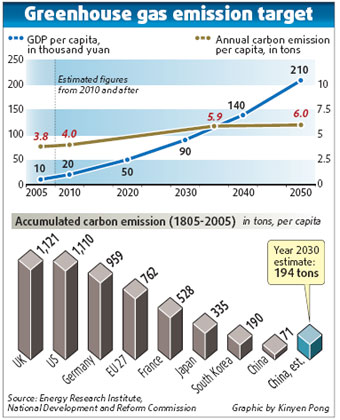
Can the Chinese eventually enjoy a standard of living comparable to developed nations while discharging less greenhouse gases?
The answer is "yes" - but it comes with a hefty price tag.
According to a National Development and Reform Commission (NDRC) research panel, the goal is achievable provided the country spends an extra 1 trillion yuan (US$146 billion) every year to raise energy efficiency.
That translates to a spending of at least 40 trillion yuan by 2050 to get on to the green track of development, Bai Quan, a senior member of the NDRC energy research institute, told China Daily yesterday.
Explaining the mathematical model that his colleagues have built, he said the money will be mainly used to introduce and spread technologies and know-how to raise the energy efficiency of end-users in industry, construction and transportation.
If the money is made available, the country's per capita greenhouse gas emissions will grow by only 50 percent during the 2010-50 period, to 6 tons from the present 4 tons. Per capita emissions stood at 3.58 tons in 2004.
The target can be made a national goal given that per capita income is expected to increase 10-fold from 20,000 yuan in 2010 to 200,000 yuan by 2050, to reach the median level in developed countries.
"It is like trying to touch the ceiling. You have to jump to do it. And if you make a good effort, you probably can," Bai said.
He told China Daily that the results of the low carbon scenario presented by his institute will be officially released in July.
Jiang Kejun, another researcher at the NDRC institute, said the project would offer a low-carbon alternative for the consideration of the top policy makers.
Low carbon emissions should be made into standard State policy at least in the 13th five-year plan (2016-20) if not in the 12th five-year beginning in 2011, Jiang said.
The government currently does not have a carbon reduction target. In energy efficiency, its goal is to achieve, from 2006 to 2010, a 20 percent cut from the 2005 level of energy consumption per unit of GDP. Similar policies will continue for the 2011-15 period, officials said.
Xie Zhenhua, the NDRC's vice-minister responsible for climate change, earlier said that the government is mapping a long-term strategy on climate change in the run-up to a global post-Kyoto protocol expected to be reached in Copenhagen later this year.
Xie has also pledged "greater efforts" to tackle climate change during the 2011-15 period.
The NDRC expert panel said the country's carbon dioxide emissions are likely to peak in 2035, at 8.8 billion tons, when industrialization and urbanization are in an advanced stage, compared with around 5.5 billion tons in 2010.
But from 2035 to 2050, emissions will remain stable or decline marginally if the proper technological route is followed, said the panel.
Cumulative per capita carbon emissions will reach 194 tons from 1850 to 2030, experts said, while the figures for the US and Europe had surpassed 800 tons and 1,100 tons from 1850 to 2005.
So, if the scenario turns into reality, China will discharge far less greenhouse gases in pursuit of economic prosperity on par with developed economies.
(China Daily May 21, 2009)